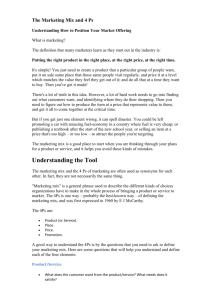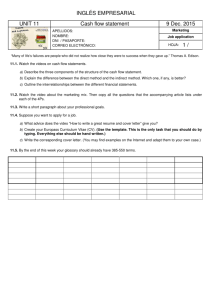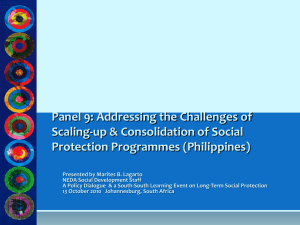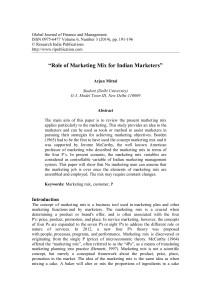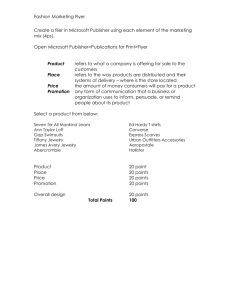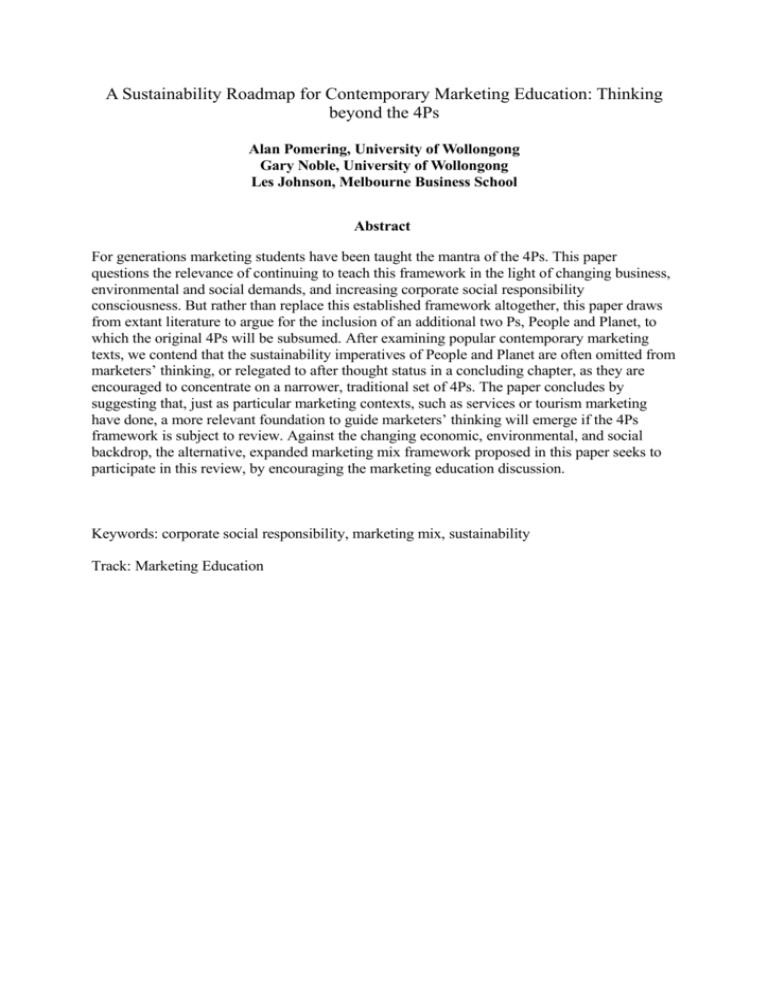
A Sustainability Roadmap for Contemporary Marketing Education: Thinking
beyond the 4Ps
Alan Pomering, University of Wollongong
Gary Noble, University of Wollongong
Les Johnson, Melbourne Business School
Abstract
For generations marketing students have been taught the mantra of the 4Ps. This paper
questions the relevance of continuing to teach this framework in the light of changing business,
environmental and social demands, and increasing corporate social responsibility
consciousness. But rather than replace this established framework altogether, this paper draws
from extant literature to argue for the inclusion of an additional two Ps, People and Planet, to
which the original 4Ps will be subsumed. After examining popular contemporary marketing
texts, we contend that the sustainability imperatives of People and Planet are often omitted from
marketers’ thinking, or relegated to after thought status in a concluding chapter, as they are
encouraged to concentrate on a narrower, traditional set of 4Ps. The paper concludes by
suggesting that, just as particular marketing contexts, such as services or tourism marketing
have done, a more relevant foundation to guide marketers’ thinking will emerge if the 4Ps
framework is subject to review. Against the changing economic, environmental, and social
backdrop, the alternative, expanded marketing mix framework proposed in this paper seeks to
participate in this review, by encouraging the marketing education discussion.
Keywords: corporate social responsibility, marketing mix, sustainability
Track: Marketing Education
Introduction
Business is under attack (e.g. Bakan 2004). Marketing is also under increasing public and
academic scrutiny (Heath and Potter 2006; Saren et al. 2007). In 2004, the American Marketing
Association (AMA) updated its marketing definition to consider the organisation’s stakeholders
for the first time (Darroch et al. 2004), while its most recent definition has moved beyond
stakeholders to consider society at large (AMA 2008). In 2005, the Journal of Marketing
opened the discussion on the need for a 'marketing renaissance'. Marketers appear to be groping
in the half-light for this renaissance. The '4Ps' (product, price, promotion, and place) framework
- has not evolved from the heady days of the US post-war manufacturing surge of the 1950s,
and, not surprisingly, is now a tool kit that marketing scholars increasingly question the value of
(Hyman 2002).
Coincidentally, the influence of marketing on corporate decision-making appears to have
waned. Grönroos (2006 p. 396), for example, claims that "marketing seems to be losing its
credibility and the marketing function is in decline". Marketing has come to be seen to be
preoccupied with tactical issues, and poorly linked to strategy (McGovern et al. 2004). Part of
the problem, according to Day and Montgomery (1999), is the lack of versatility of the 4Ps
framework in the face of changing market conditions.
A marketing definition should strengthen marketing’s organisation role (Grönroos 2006), and it
should reflect changes in the environment (Cooke, Rayburn and Abercrombie 1992). The
purpose of this paper is to review the 4Ps framework that typically forms the foundation of how
marketing is taught in universities and business schools around the world. We propose an
alternative framework that reflects an age of increasing social and environmental responsibility,
which recommends the addition of an extra two Ps - People and Planet, in line with Elkington’s
(1997) Triple P reporting framework of People, Planet, and Profit – to guide marketing
education and management thinking. We argue that it is critical for contemporary educators and
scholars to accommodate such an alternative framework to ensure social responsibility and
sustainability underpin future marketing management thinking and decision-making.
While a first glance may perceive our intention to replace one dogma with another, the purpose
of this paper is essentially to encourage discussion and scrutiny of a key framework of
marketing education, one in apparent need of revision. This paper is structured as follows: we
review the 4Ps framework, examine some of the alternative frameworks proposed in its place,
and then elaborate our proposed framework We conclude with a brief discussion of the
implications of our proposed approach for marketing education and educators, and, critically,
key stakeholders in this education process: marketing students, managers, business, and society.
The Current 4Ps Framework
The 4Ps suggest the elements an organisation can and must control in tailoring its product offer
to the market: product, price, promotion, and place. Since the 1950s, marketing has been
dominated by this framework to describe the scope of marketing activities (Grönroos 2006). It
is seen as offering a useful guide to major categories or marketing activity (Czinkota and
Kotabe 2001), and of such importance that it provides the organising framework for "almost all
marketing textbooks and courses" (Shapiro, Dolan, and Quelch 1985 p.7). Although scholars
have argued the framework is increasingly irrelevant to marketing management practice (e.g.,
Grönroos 2004; Gummesson 1999), and that it is conceptually flawed (e.g., Day and
Montgomery 1999; Dobscha and Foxman 1998), Hyman (2002) observes that marketers (e.g.,
Anderson and Taylor 1995; Vignali and Davies 1994; Yudelson 1999) continue to use and
defend it, as it represents the broad decision-making domains faced by marketing managers.
While the 4Ps framework may have been suitable for the conditions of post-Second World War
expansion in the US, its relevance is questionable for today's marketplace. Brownlie and Saren
(1992) argue that consumers' and society's requirements of business are now broader than
purely economic criteria, with production and procurement functions now expected to tackle
major sustainability challenges. Indeed, supply chains have become more important as
consumers scrutinise firms' overall marketplace practices, beyond products, prices, promotions,
and place. More than a decade later, Dev and Schultz (2005) have suggested senior
management should redefine what marketers can do to make the field more relevant and better
adapted to today's market realities.
A move in this direction is reflected in the American Marketing Association’s recent
redefinition of marketing: “Marketing is the activity, set of institutions, and processes for
creating, communicating, delivering, and exchanging offerings that have value for customers,
clients, partners, and society at large” (AMA 2008). Such a move, we believe, also requires a
more fundamental critical review of the 4Ps framework.
Coming to terms with the issues of globalisation and the social responsibility of corporations,
including sustainability, 'product' may still sufficiently interpret attributes of design and
construction, and functional benefits, but it is insufficient to describe the supply-chain,
manufacturing, and post-consumption disposal issues stakeholders are increasingly interested
in. Just as marketing scholars and managers have traditionally conceived product in functional
terms, so have price, promotion, and place also been conceived. Price, for example, rarely
includes the total cost of the negative externalities of the production process. These negative
externalities are increasingly important in the quest for sustainable development.
Criticism of the Current 4Ps Framework
The 4P mantra, intoned by generations of marketing students, ignores the primacy of customers,
prospects, and even markets (Dev and Schultz 2005). Brownlie and Saren (1992 p. 34) argue
the framework's primacy in marketing scholarship was achieved "on the wave of the fiery
polemics of disciples such as Levitt and Kotler, to the point where it now assumes many of the
characteristics of a normative ideology, or an article of faith, rather than a concept”. Brownlie
and Saren (p. 38) question whether the framework as it has been propagated can provide a basis
for successful business given it was "an idea born in the conditions of post-Second World War
expansion in the USA". The future, they contend (p. 39), will be about focusing on more
environmental and social issues: "Techniques for control over resources and supplies may
become far more pressing than those for market control, and attention to the natural
environment and resource conservation is likely to alter the nature of consumption and relative
status of the consumer".
Companies such as The Body Shop have successfully positioned themselves as concerned with
a wider array of issues than the 4Ps. Others, such as Shell and BP, are attempting to emulate
this pro-social stance. Marketplace polls report the public wants business to play a broader role
in society than driving shareholder wealth, want to hear how business is doing this, and will
reward more socially responsible organisations for doing so (e.g. Environics 1999). A future
challenge for marketers and marketing educators will be how to meet this market-driven
preference. We acknowledge that recent marketing texts (e.g., Kotler et al. 2007) are
incorporating discussion of responsible marketing to deal with increasingly important
environmental and social issues, however, this perspective is typically treated as separate to the
notion of the controllable marketing mix framework, where we argue it more appropriately
belongs.
Extant Alternative Frameworks
It has been suggested that attempts to modify the 4Ps framework are misguided (e.g., Anderson
and Taylor 1995); weight of evidence (Hyman 2002), however, argues that the current
framework is an anachronism. Grönroos (2006 p. 395) observes "During the last 25 years
marketing as a phenomenon has changed". Various alternatives to the 4Ps have been proposed.
Hyman (2002 p. 927) suggests replacing the 4Ps with an appropriately alliterative mnemonic
device of 8 Ds that, while imperfect, is a "starting point for subsequent development". The first
four elements of this set - design, demand, didactics, and distribution - are reminiscent of
McCarthy's 4Ps, but the fifth - duty - explicitly addresses marketing ethics and social
responsibility. Duty covers ethics in all domains, such as advertising ethics and sales force
ethics, but also covers topics such as the political environment and legal environment,
consumerism, and green marketing. Hyman (p. 928) argues that making ethical concerns
explicit to marketing management pedagogy is warranted, given: “(1) current Association to
Advance Collegiate Schools of Business (AACSB) guidelines for curriculum-wide coverage of
ethical issues (cf Laczniak 1993); (2) the growing belief of instructors, students, and
practitioners that ethics instruction in business is important (cf Priddle 1994; Shannon and Berl
1997); and (3) students' preference for integrating ethics into various business courses rather
than taking a separate compulsory or elective ethics course (Stewart et al., 1996)”. The final
three Ds - direction, diary, and dialectic - address marketing strategy, research, and practice.
Yudelson (1999) argues that a reconsideration of McCarthy’s (1960) 4Ps is essential for the
new millennium, but this should be based on adaption rather than revolution. Yudelson’s new
4Ps – performance, penalty, perception, and process – do not venture beyond the preoccupation
with meeting the individual customer’s needs, however, and therefore ignore the new
millennium’s social and environmental sustainability imperatives.
The marketing mix has undergone modifications for specific marketing situations, such as the
experience contexts of services and tourism. In the services context, for example, characteristics
that distinguish the service product from manufactured products, such as intangibility and
inseparability (e.g. Lovelock 1991, have lead to a focus on processes, the physical environment,
and people. The experience and credence nature of many services require approaches that go
beyond those appropriate for more readily available search attributes. The additional Ps we
propose would equally apply to such marketing contexts. We view People from social
responsibility and sustainability considerations, however, compared to services marketing’s
interpretation of People from a customer mix and employee management perspective.
Proposed Alternative Framework
Given the imperatives for future business of sustainability and the growing recognition of the
legitimacy of corporate social responsibility (CSR), we propose the addition of Planet and
People to the original 4Ps framework in order to bolster a contemporary framework’s efficacy.
Grönroos (2006 p. 397) argues that a framework "should be generic enough to cover a large
variety of products"; we believe that our additions accomplish this. We do not disregard the
clarity the 4Ps provides in highlighting four functional areas that marketing managers must
manage, but we widen the manager’s scope of control and responsibility to include a key
stakeholder, People, and a philosophy of environmental concern, under the rubric of Planet. In
other words, we extend the utility of the 4P framework from a limited marketing management
tool, more appropriate for the post-war production era of the 1950s, to include elements of
social and environmental responsibility, and sustainability, to guide marketing’s, and indeed an
entire organisation’s, management philosophy. We do so by suggesting that People and Planet
subsume the traditional 4Ps, rather than be considered as merely additive. In this way, all
marketing mix decisions will be considered against their implications on People and the Planet.
The two additional elements, drawn from the Triple Bottom Line reporting framework of
People, Planet and Profit (Elkington 1997), overarch the policies and practices of the
organisation and reveal a facet of the business that otherwise might remain hidden. Keeping
certain aspects of a business' operations hidden from the scrutiny of the market may have once
helped to protect the corporate image, but new economy marketplace conditions such as
networked activist communities, greatly enabled by the internet, and greater levels of scrutiny
by government and non-government watchdog organisations, are making such information
asymmetries less possible, and transparency more necessary. Consumer activism, including
boycotts and occasionally damage to the physical assets of perceived egregious brands, such as
recent attacks on the distribution outlets of McDonald’s, Shell, and Nike, reinforce that
marketing's face is not simply summarised in the traditional 4Ps framework.
Rather than seeing it as captive to a tool box of concepts such as the 'marketing mix', we agree
with Drucker’s (1954) observation that marketing is the face of the business seen from the
customer’s point of view. In extending the marketing mix framework we honour the legacy of
earlier marketing thinkers, such as Jerome McCarthy, but acknowledge the necessary change in
perspective that is critical to business, and therefore marketing, in the 21st century. This
includes an organisation's commitment to its social and environmental responsibility.
Elkington (1997) interprets People to refer to fair business practices toward employees and the
communities within which a corporation conducts its business, and seeks the minimisation of
negative social externalities, and even ‘giving back’ for these societal stakeholders.
Planet essentially refers to sustainable environmental practices, including the minimisation of
negative environmental externalities as a result of the firm’s operations. Current guidelines for
such an approach include, for example, the UN Global Compact, and the social responsibility
investment index, Socrates’ articulations of the seven domains that might guide a firm’s CSR:
employee relations and diversity programs, ethical materials sourcing, product design,
marketing programs, the environment, human rights, and corporate governance (Kinder,
Lydenberg, Domini & Co. Inc. 2006).
Profit, the third element of triple P reporting, not surprisingly, is the result of the activities and
operations of the firm that cascade from decisions made around the extended 6Ps. Consumers
have indicated that they expect firms to make a greater contribution to society and the
environment, and will reward those firms that do so (e.g., Environics 1999), effectively putting
business on notice. A recent way of backlashes against Chinese exporters of pet food, toys, and
food products have resounded this warning to manufacturers and brand managers.
We may be criticised for simply 'bolting on' two suitably mnemonic and fashionable elements
to McCarthy's original 4Ps, but refute criticism that our efforts are trite. Elkington's Triple P
paradigm is an accepted contemporary business perspective, and has been adopted by
corporations in their quest to meet consumers’ and other stakeholders’ increasing CSR
expectations via sustainability/CSR reporting (Shell, for example, commenced its 'People,
Planet and Profit' reporting in 2003). Rather than fashionable, which has rather pejorative
connotations, we see our proposed marketing mix framework as timely, meeting the needs of
academics (e.g. Brownlie and Saren 1992) that have called for such a contemporary approach.
Further, our suggestion that marketing educators and business consider how marketing activities
affect the planet and people is in keeping with the World Business Council for Sustainable
Development's stated role for contemporary business: "the commitment of business to
contribute to sustainable development, working with employees, their families, the local
community and society at large to improve their quality of life" (WBCSD, 2004).
The recent move to consider People and Planet aspects of business operations in annual
reporting reflects the increasing primacy corporations are placing on this wider scope of their
activities. The SAS Group’s Annual Report and Sustainability Report, Shell’s People, Planet,
and Profit Report, launched in 2003, and Brown and Williamson Tobacco’s Social and
Environmental Report 2001/2002 are examples of companies that have accepted the changed
landscape of these new sustainability demands. Brown and Williamson Tobacco’s report
(2001/2002 p. 38) states: “We recognize that a commitment to social reporting is a commitment
to change”. The addition of People and Planet to the marketing mix framework would enhance
the marketing manager’s sustainability consciousness in managerial decision making
concerning product, price, promotion, and place. For marketing educators to not have this
discussion is to lock our thinking and teaching into a framework born of the need for post-war
reconstruction, not the construction of a sustainable future, and, therefore, potentially deny
marketing this same commitment to change.
Conclusion
Implicit for an organisation's marketing is that it follows a market orientation (e.g. Kohli and
Jaworski 1990), and combining its resources and skills into core competencies (e.g. Prahalad
and Hamel 1990) distinctively well relative to competitors. This way, the organisation’s valuecreation strategy will not be able to be duplicated by current or potential competitors (Barney
1991). Increasingly, due to pressures on business that affect our collective survival, and
consumers’ increasingly pro-social expectations of business (e.g. Environics 1999), this
competitive advantage is likely to be based on sustainable business practices. In fact,
sustainable business practices may become the new baseline for business. Our expanded 6Ps
approach offers a contemporary view to help ensure marketing educators, marketers, and
organisations are equipped for this task.
References
American Marketing Association (2008), “What are the definitions of marketing and marketing
research” [online] Available at: http://www.marketingpower.com/content4620.php [Date
accessed: 26 Feb 26 2008]
Anderson, L McTier, and Taylor, Ruth Lesher (1995) “McCarthy’s 4Ps: Timeworn or timetested?” Journal of Marketing Theory and Practice Vol 3 (Summer) pp.1-9
Bakan, Joel (2004) The Corporation: The Pathological Pursuit of Profit and Power New York:
Free Press
Barney, Jay (1991) “Firm resources and sustained competitive advantage” Journal of
Management Vol. 17 (1) pp. 99-120
Brown and Williamson Tobacco (2001/2002), Social and Environmental Report 2001/2002
Printed by Brown and Williamson Tobacco
Brownlie, Douglas, and Saren, Michael (1992) “The four Ps of the marketing concept:
Prescriptive, polemical, permanent and problematical” European Journal of Marketing. Vol. 26
(4) pp. 34-47
Czinkota, Michael R, and Kotabe, Masaaki (2001) Marketing Management, 2nd Edition, SouthWestern College Publishing, Cincinnati
Darroch, Jenny Miles, Morgan P, Jardine, Andrew and Cooke, Ernest F. (2004) “The 2004
AMA definition of marketing and its relationship to a market orientation: An extension of
Cooke, Rayburn, & Abercrombie (1992)” Journal of Marketing Theory and Practice Vol. 12
(4) pp 29-37
Day, George (1994) “The capabilities of market-driven organizations” Journal of Marketing
Vol. 58 (October) pp. 37-52
Day, George and Montgomery, David (1999) “Charting new directions for marketing” Journal
of Marketing Vol. 63 (Special Issue) pp. 3-13
Dev, Chekitan S, and Schultz, Don E (2005) “In the mix” Marketing Management Vol. 14 (1)
pp. 18-34
Dobscha, Susan and Foxman, Ellen (1998) “Rethinking the principles of marketing source:
Focus on exchange” Marketing Education Review Vol. 8 (1) pp. 47-57
Drucker, Peter (1954). The Practice of Management New York: Harper and Row
Elkington, John (1997) “Cannibals with Forks: The Triple Bottom Line of 21st Century
Business Oxford: Capstone Publishing Ltd.
Environics: (1999), "The Millennium Poll"[online] Available at: http://www.mori.com [Date
accessed 24 May 2006]
Grönroos, Christian, (2004) “From marketing mix to relationship marketing: Towards a
paradigm shift in marketing” Management Decision Vol. 32 (2) pp. 4-21
Grönroos, Christian (2006) “On defining marketing: Finding a new roadmap for marketing”
Marketing Theory Vol. 6 (4) pp. 395-417
Gummesson, Evert (1999) Total Relationship Marketing Oxford: Butterworth Heinemann
Hyman, Michael R (2004) “Revising the structural framework for marketing management”
Journal of Business Research Vol 57 (9) pp. 923-932
Kohli, Ajay K and Jaworski, Bernard J (1990) “Market orientation: The construct, research,
propositions, and managerial implications” Journal of Marketing Vol. 54 (2) pp.1-18
Kotler, Philip and Keller, Kevin Lane (2006), Marketing Management 12h Edition, New Jersey:
Pearson Prentice Hall
Laczniak, Gene R (1993) “Marketing ethics: Onward toward greater expectations” Journal of
Public Policy Marketing Vol. 12 (1) pp. 91-96
Lovelock, Christopher, H (1991) Services Marketing 2nd Edition, New Jersey: Prentice Hall Inc.
McCarthy, E. Jerome (1960) Basic Marketing: A Managerial Approach Homewood, IL: Irwin
McGovern, Gail J, Court, David, Quelch, John A, and Crawford, Blair (2004) “Bringing
customers into the boardroom” Harvard Business Review Vol. 82 (11) pp. 70-80
Prahalad, CK and Hamel, Gary (1990) “The core competence of the corporation” Harvard
Business Review Vol. 68 (3) pp. 79-91
Priddle, John (1994) “Marketing ethics, macromarketing, and the managerial perspective
reconsidered” Journal of Macromarketing Vol. 14 (2) pp. 47-62
Saren, Michael MacLaren, Pauline Goulding, Christina Elliott R., Shankar, Avi and Caterall,
Miriam (2007) Critical marketing: Defining the field London: Butterworth-Heineman
Shannon, J Richard and Berl, Robert L (1997) “Are we teaching ethics in marketing?: A survey
of students’ attitudes and perceptions” Journal of Business Ethics Vol.16 (10) pp. 1059-75
Shapiro, Benson P, Dolan, Robert J, and Quelch, John A (1985) Marketing management
principles, analysis, and applications Vol. 1 Homewood: Richard D. Irwin
Stewart, Karen, Felicetti, Linda and Kuehn, Scott (1996) “The attitudes of business majors
toward teaching of business ethics” Journal of Business Ethics Vol. 15 (8) pp. 913-18
Vignali, Claudio and Davies, Barry J (1994) “The marketing mix redefined and mapped”
Management Decision Vol. 32 (8) pp. 11-16
World Business Council for Sustainable Development (2004), Cross Cutting Themes –
Corporate Responsibility [online] Available at: http://www.wbcsd.org [Date accessed: 21 May
2004]
Yudelson, Julian (1999) “Adapting McCarthy’s four P’s for the twenty-first century” Journal of
Marketing Education Vol. 21 (1) pp. 60-67

